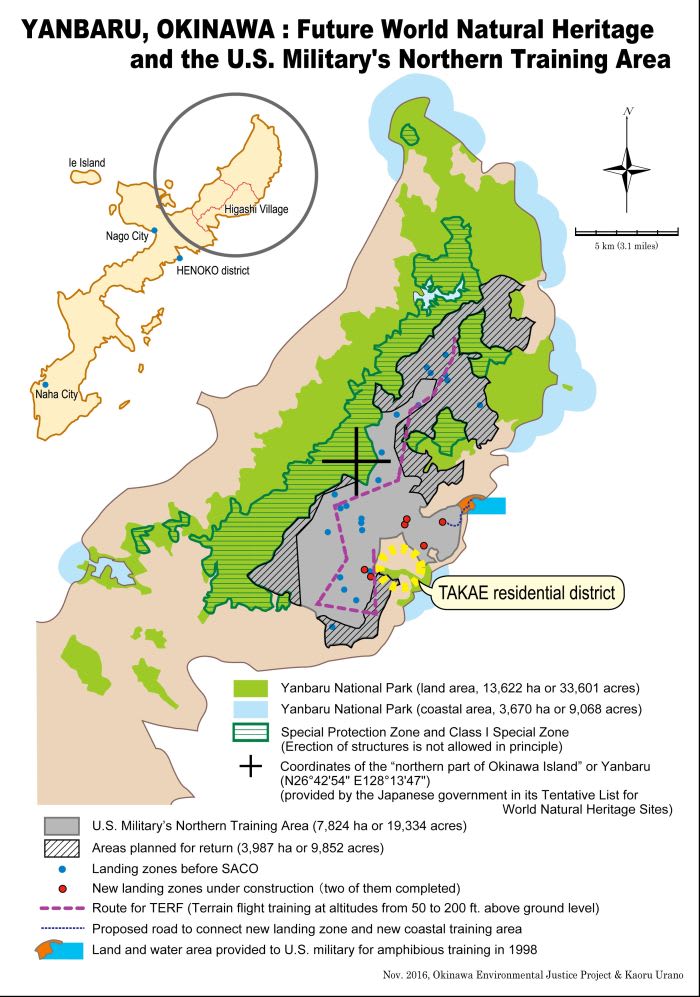SDCCでは、IUCNハワイ会議報告集を作成しました(10/6発行)。
その中の記事「外来種対策強化を求めるIUCN決議で、辺野古埋め立てを阻止しよう!」です。
英訳も作成しましたので、どうぞお読みください。
米国・ハワイ州で開かれた国際自然保護連合(IUCN)第6回世界自然保護会議(WCC)に日本の環境6団体(注1)が提案した動議17「島しょ生態系への外来種の侵入経路管理の強化」が8月31日(日本時間)に採択されました。政府関係で賛成80、反対2、棄権が74。NGO関係で、賛成が459、反対が24、棄権が204。いずれも賛成過半数で採択されました(注2)。日米両政府は棄権。2000年、2004年、2008年に続く4度目の勧告・決議です。翁長沖縄県知事は「誠に喜ばしい」「IUCNの度重なる勧告を真摯に受け止め、辺野古の美しい海を埋め立てる現行計画を断念していただきたい」との談話を発表しました。
侵略的外来種問題は生物多様性に大きな脅威となっています。2010年生物多様性条約第10回締約国会議(議長国・日本)では、2020年に向けて愛知目標9「侵略的外来種のうち優先度の高い種を制御し、根絶する。その導入や定着を防止する対策を講じる」を決定しました。2012年にはIUCN第5回WCC(韓国・チェジュ)で決議するなど深刻な問題になっています。愛知目標を提案・決定した日本政府が、米軍基地建設のために外来種が混入する恐れがある埋め立て土砂1700万㎥を本土や奄美大島、徳之島から名護市辺野古に運ぶなど許されるはずもありません。
環境省は搬出予定地の広島や瀬戸内に侵略的外来種アルゼンチンアリが広範に繁殖していることを認めています。沖縄のパイナップルやサトウキビなど農作物に影響を与える可能性があります。防衛省・沖縄防衛
局は「外来種対策は業者に任せている」と無責任な態度に終始しています。
採択された決議(主文は12面)は①IUCN本部に、外来種を早期に発見するモニタリング能力を高めること②日本政府に、埋め立て土砂搬出前に、混入する外来種の早期発見方法を確立すること③米国政府に、日本政府に協力して沖縄に入る外来種の影響を最小化することなどを具体的に提言しています。動議を作成した安部真理子さん(日本自然保護協会)は「この決議は埋め立て土砂にとどまらず、あらゆる外来種を防ぐ厳しいものだ」とその意義を語っています。
日本政府は「IUCNは科学者の意見」「決議には拘束されない」と国際世論に背をむけています。私たちはIUCN世界自然保護会議で「外来種対策強化を求める動議17と過去3度の勧告決議の履行を求める」国際署名を集め、82か国・1513人から賛同を頂きました。今後、各地での報告会や沖縄県交渉、政府交渉・署名の提出などを取り組み、国内外に辺野古・大浦湾の埋め立てが非科学的であり、愛知目標に反することを明らかにしていきます。
(注1)6団体は日本自然保護協会、ジュゴン保護キャンペーンセンター、WWFジャパン、日本野鳥の会、ラムサール・ネットワーク日本、野生生物保全論研究会。
(注2)政府関係とNGO関係のそれぞれにおいて、賛成過半数で採択されると動議は承認されます。棄権は投票数にはカウントされません。

ポスター発表をする安部真理子さん(右)
Stop the Reclamation of Henoko & Oura Bay, Okinawa, Japan!
Call for Implementation of IUCN Resolution to Strengthen Provisions on Invasive Alien Species
At the 6th World Conservation Congress (WCC) of the International Union for Conservation of Nature (IUCN), the motion 17: Strengthening pathway management of alien species in island ecosystems, made by 6 Japanese environmental organizations (Note 1), was adopted on August 31 (Japan time). The vote was 80 ayes, 2 noes, and 74 abstentions among the government-related entities, and 459 ayes, 24 noes, and 204 abstentions among the NGO-related entities. The motion was adopted by a majority in both cases (Note 2). The Japanese and U.S. Governments abstained from voting. This is the 4th recommendation and resolution, following those made in 2000, 2004, and 2008. The governor of Okinawa Takeshi Onaga, commented: “The resolution is highly favorable” and “ I would like the governments to take the repeated recommendations seriously and to abandon the plan to reclaim the beautiful sea of Henoko.”
Introduction of Invasive alien species is a serious threat to biodiversity. Aichi Biodiversity Target 9 was decided in 2010 at the10th Conference of the Parties to the Convention on Biological Diversity, hosted by Japan. It states that: “By 2020, prioritized invasive alien species are controlled or eradicated, and measures are in place to manage pathways to prevent their introduction and establishment.” In 2012, it was resolved at the 5th IUCN WCC, held in Jeju, Korea. The government of Japan proposed and decided Aichi Target. On the other hand, the same government is planning to transfer 17 million cubic meters of soil and rock from mainland Japan and two islands, Amamioshima and Tokunoshima, to the planned construction site of the United States Marine Corp Facility at Henoko. How can it be allowed?
The Ministry of the Environment acknowledges that the Argentine ant, one of the invasive alien species, is widespread in Hiroshima and Setouchi, planned sites of landfill materials’ extraction. It can affect the crops, such as pineapples and sugar canes. Okinawa Defense Bureau of the Ministry of Defense commented irresponsibly: “As for the measures against alien species, we leave it all to contractors”.
The resolution specifies the concrete measures such as follows:
a. requests the IUCN to strengthen capacity in early detection and monitoring of invasive alien species;
b. urges the Government of Japan to develop methods for early detection of alien species in landfill materials prior to their transfer to Henoko;
c. Invites the Government of the United States to minimize the impact of alien species establishing themselves in Okinawa, in collaboration with the Government of Japan.
Dr. Mariko Abe, the Nature Conservation Society of Japan, explains: ”This resolution is not only about the landfill materials. It is to prevent all kinds of alien species.”
The Government of Japan is contrary to the world opinion and commented: “The resolution of the IUCN is just an opinion of scientists”, and “We are not bound by the resolution”. At the IUCN World Conservation Congress, we have collected signatures of 1513 people from 82 countries to call for implementation of motion 17, which demands strengthening the measures against alien species, and the recommendations and resolution adopted 3 times previously .
Our planned activities include holding brief sessions, negotiations with the Prefecture of Okinawa and the Government of Japan, and submission of the signatures. We will prove that the reclamation of Henoko and Oura Bay is scientifically against Aichi Target.
Note 1: 6 organizations are: the Nature Conservation Society of Japan, Save the Dugong Campaign Center, WWF Japan, Wild Bird Society of Japan, Ramsar Network Japan, and Japan Wildlife Conservation Society.
Note 2: A motion is adopted when the vote achieves a majority in each of the government-related entities and the NGO-related entities. Abstentions are not counted as the votes cast.






 ZAN
ZAN






 ZAN
ZAN












 沖縄県HPより
沖縄県HPより













 次回のおきなわ茶会は2月を予定しています
次回のおきなわ茶会は2月を予定しています













 ホワフォワの部分がサトウキビの花です
ホワフォワの部分がサトウキビの花です
 甘~い黒糖になるでしょう。
甘~い黒糖になるでしょう。
 なこの頃に
なこの頃に
 オスプレイ墜落したってよ
オスプレイ墜落したってよ
 目が覚めた
目が覚めた
 頭がおかしいとしか思えない。
頭がおかしいとしか思えない。 

 ダメったらダメ
ダメったらダメ




